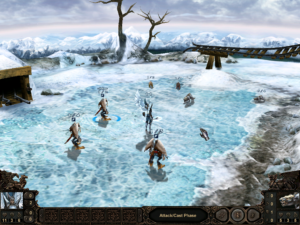Etherlords: The four armies
Magic: The Gathering has five colors of magic:
Red is fire, chaos, and destruction. Red has a lot of direct-damage spells (things like fireballs and lightning bolts), as well as spells to destroy land cards and artifacts. Red creatures tend to be straigthforward melee machines like orcs and minotaurs, and stronger on attack than defense.
Green is the the color of growth and vegetation. Green creatures tend to be either wild animals or elfy stuff. Green has some of the strongest creatures in the game, but it also has good buffs, and can succeed by bringing out lots of small, cheap creatures and making the ones that survive stronger. Green is also a good color for getting extra mana.
Blue’s main theme is magic itself, and to a certain extent intelligence, air, and water. Blue spells specialize in metamagical trickery: spells that affect other spells tend to be blue, as are spells that let you draw extra cards and the like. Blue creatures tend to have special powers, and can often fly (which means they can’t normally be blocked by non-fliers).
Black has undead and demonic creatures, many of which have nasty combat side-effects — for example, growing stronger by killing creatures, or making the enemy discard cards when not blocked. Black is also notable for spells that have negative side-effects for the caster, and in particular has effects that require “sacrificing” one of the caster’s creatures.
White is the chivalry and holiness color, and features most of the healing and protection effects in the game. White creatures tend to be knights and other soldiery types, and there are some white effects that buff everything of a particular type, encouraging the player to create homogenous armies.
Now, you’ll notice that each color has both a theme in the game’s fiction and some tendencies in how it plays. These are separate things, and Etherlords demonstrates this by separating them.
The Chaots have Etherlords‘ version of red magic, with its orcs and kobolds and cheap direct-damage spells. Because of those direct-damage spells, it’s the one side that’s most faithful to M:tG. But it also has good defensive creatures, and it has the Kobold Shaman, which can “rest” 1Etherlords calls “rest” what M:tG calls “tap”. All it means is that this is an ability that a creature can use once per turn, and only if it hasn’t participated in an attack. to do 1 point of damage to any player or creature — which makes it equivalent to M:tG‘s Prodigal Sorcerer, a blue creature. Also, it has the best creature buffs in the game, which makes it more like green.
Green magic is represented by the Vitals. The elfy stuff has been dropped, leaving creatures like snakes and hornets and giant ticks. Where M:tG has green creatures that can grant you extra mana when tapped, Etherlords has spells that give you an instant mana boost, including the “Sacrifice” spell, which would definitely be black in M:tG. I have trouble discerning overall trends in the Vitals, though. It’s a versatile side.
Blue is replaced by the Kinets, which are described as creatures of icy logic and experts in rapid movement, although I don’t really see how this is reflected by the blue spells. Mainly what we have here is cheap flying creatures and defensive buffs, although, as with the Vitals, this can vary a lot depending on what sorts of creatures you put into your deck. Warrior Spirits, for example, seem like they could be a very effective basis for a Kinets deck, despite not flying, because of their Lifetap ability (which heals you as it damages the enemy), but I haven’t really been able to try it. Maybe on a more advanced map.
The Synthets take the place of black, and are definitely the one side that’s most changed: synthets are bizarre semi-mechanical beings. Apart from the heroes, they don’t even look like modified organisms; they just look like things that naturally have wheels and springs as components. Although it doesn’t have many sacrificial abilities, the overall theme of the Synthet side seems to be not caring whether your creatures live or die. Synthet creatures are disposable, and often have some form of innate ability to regenerate or return from the dead. There’s even a cheap Synthet resurrection spell that, as a bonus, does 1 point of damage to the enemy. Synthets also have a wide assortment of debuffs, as well as the spell “Twisted Enhancement”, an interesting enchantment that grants +2/+2 to a creature, but then lowers its stats by 1/1 every turn until it dies. This is obviously a way to get the most out of one of your disposable creatures, but in some situations it can also be cast on an opponent’s creatures to kill them off.
There is of course no white side. The healing and protection side of white seems to be mostly taken over by the Vitals, while the business of powering up everything of a given type is spread out through all the sides, mainly by means of “Elder” types of specific species (for example, an Aviak Elder powers up all Aviaks). Really, most abilities are spread out through all sides like this. That’s sort of true in M:tG as well, but it’s not as necessary there, because M:tG allows the possibility of making a multi-color deck. In Etherlords, each hero belongs to one and only one side, and can only obtain spells belonging to that side.
| ↑1 | Etherlords calls “rest” what M:tG calls “tap”. All it means is that this is an ability that a creature can use once per turn, and only if it hasn’t participated in an attack. |
|---|
 Comments(0)
Comments(0)